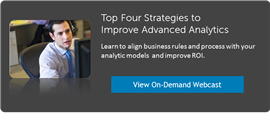 From large enterprises to small businesses, organizations today generally recognize the range of opportunities and potential benefits they can achieve by analyzing big data. Whether the plan is to draw from social media posts to create targeted marketing promotions, find trends in banking transactions to better detect fraud, use telecommunications data to improve cell phone networks or something else, organizations know that big data can hold the key to important insights.
From large enterprises to small businesses, organizations today generally recognize the range of opportunities and potential benefits they can achieve by analyzing big data. Whether the plan is to draw from social media posts to create targeted marketing promotions, find trends in banking transactions to better detect fraud, use telecommunications data to improve cell phone networks or something else, organizations know that big data can hold the key to important insights.
Not surprisingly, many organizations are very eager to get started. But before you dive in head first, consider asking (and answering) some basic questions, including: What business goals do you want to accomplish? How will you manage all that data? And how will you deliver insights across the organization? Taking a holistic view of big data analytics can help you maximize the business benefits you achieve.
Adopt a business perspective
It’s easy to get caught up in the technical challenges and goals of big data analysis. But analyzing a large volume and variety of data will mean little unless you adopt a business perspective. What business questions do you want to answer? How do you intend to apply new insights to business goals? Answering these and similar questions can help you enhance the efficiency of big data analytics projects and deliver results that have a tangible impact on the business.
Understand the whole information lifecycle
Once you’ve defined your business goals, make sure you understand the whole data lifecycle before you start analyzing. Ask yourself, for example:
- Where is the data coming from? For example, are you planning to use data from a few internal databases? Or do you want to capitalize on the tremendous volume and variety of data available from external sources? Will you analyze historical data from databases? Do you want to analyze data streaming in from sensors?
- How will you integrate data? Integrating data from multiple sources helps maximize the value of big data — you can add context to data that ultimately enhances insights. But of course, you need a strategy to accomplish that integration.
- How will you move data? In some cases, you’ll need to move data from its native environment to an analytics environment. But how can you do so without creating performance issues, introducing errors or jeopardizing data security?
- What will you analyze? Use a business perspective to help understand which data can generate the greatest value for your business.
- How will you store and archive data? As the volume of big data continues to grow exponentially, you need a strategy for storing all of it (or it least the valuable parts of it). Determine whether you’ll need to keep newly captured data for certain period of time to maintain compliance with government regulations.
A holistic perspective of the data lifecycle help you efficiently address immediate goals while also facilitating more long-term planning.
Make insights accessible to everyone
Data scientists are hot commodities today. Organizations are readily seeking people with the right combination of skills to help transform data into business insights. But while data scientists can make key contributions to big data analytics, the insights they help generate should be accessible to a wide range of individuals, not just people with technical expertise. Before you start analyzing data, consider how you will deliver information to the executives and line-of-business managers who are responsible for executing on business strategies.
As you plan your big data analytics journey, make sure you know your business goals, understand the data lifecycle and have a plan for delivering insights to everyone who needs them. Taking a holistic approach to big data analytics will be an important step in addressing technical challenges and reaching your business goals.
Next steps
See how you can easily extend data-driven insights with advanced analytics when you watch this educational on-demand session. You’ll learn how to realize the full potential your data offers and keep up with the demand for greater insights.



